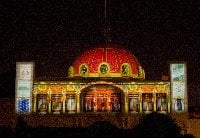Mobile marketing
North Tyneside Council is exploring ways of using mobile technology as a tool for promoting cultural events. Kevin Wallace explains.

Now that practically the entire target audience for the arts is online and over a quarter carry the Internet around in their pockets, the pressure on cultural organisations to take their marketing tactics ‘viral’ is growing. Whilst ever-changing and increasingly-complex technologies may seem like more effort than they are worth, the results of pilot projects are proving that the potential to engage audiences virtually, and specifically through mobile phones, is a resource that needs to be harnessed.
North Tyneside Council (NTC) recently collaborated on a project with Culturescape to pilot the use of QR codes and mobile-friendly web content as a promotional tool for a cultural event. The idea of Shimmer was to map a stunning digital projection on to the iconic Spanish City Dome, in Whitley Bay. The nearby beach and promenade were also animated by a series of site specific projections and installations reflecting the themes and traditions of the seaside location.
Since NTC’s website was not mobile-ready, it was agreed that Culturescape would format and host the Council’s content. A central project homepage was created and this was used as the target page for a Quick Response (QR) code. Email campaigns were sent to the NTC Arts Service and NTC Events mailing lists. A shortened url was included in the emails and printed on a promotional leaflet, alongside the QR code.
An online comment form was added to the website to collect feedback and the QR code and a homepage link were printed on postcards, which were given out at the event. Three tracking systems were used to record traffic to the Shimmer pages: Google Analytics for an overview of all web traffic; Delivr for url shortening and QR code traffic; and PercentMobile for detailed mobile device recording.
The majority of traffic was generated through the email campaign, although Facebook was also a significant source of referrals. There are no standards against which to compare effectiveness of the digital marketing campaign, however reference points and comparisons suggest that the results were outstanding. Cross referencing the email campaign with a timeline of web traffic reveals an estimated click through rate (CTR) of 34%. Industry benchmarks consider a CTR of 2-12% healthy and would not expect even a highly personalised email list to generate more than a 20% CTR. The number of unique visitors increased steadily as the event approached and nearly 70% of visitors to the site were located in the catchment area of the event, which is just as we would hope.
Overall, mobile usage constituted somewhere between 17.8-20.8% of all visits; a significant amount, demonstrating both the value and success of formatting the content as mobile-ready. The QR code generated a relatively low number of scans but did constitute half of all mobile visits. This suggests that the remaining users probably clicked through to the site from an email, meaning it is likely at least half of the mobile audience use their smartphones to keep up-to-date with their emails.
The project proved that mobile ready content will genuinely engage users across all platforms. Building in a feedback loop introduced an avenue of evaluation beyond the usual audience surveys and seems a natural extension of our use of mobile technology. Having one platform that offers so much shows that this approach has huge potential in the cultural sector.
Join the Discussion
You must be logged in to post a comment.